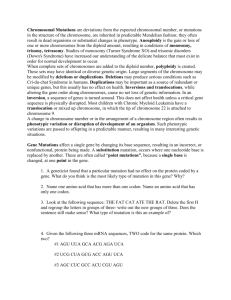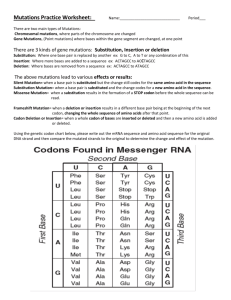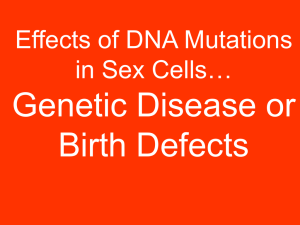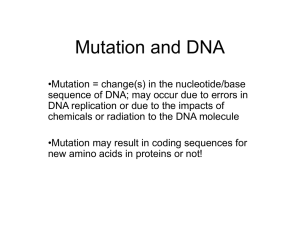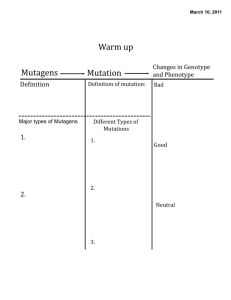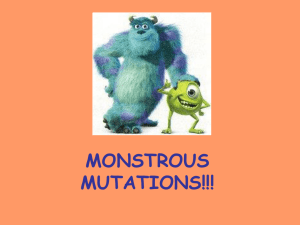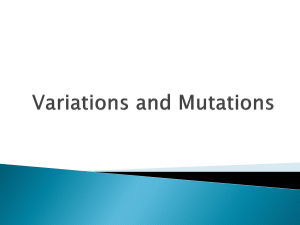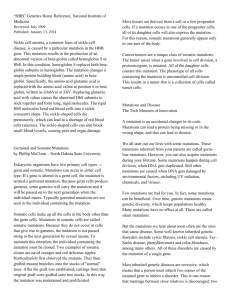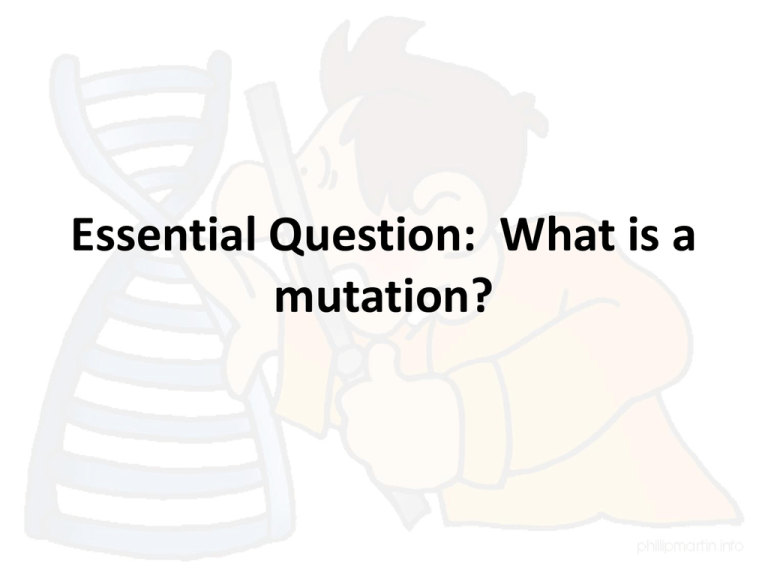
Essential Question: What is a
mutation?
Think about it:
What happens if our DNA gets messed
up?
Cells sometimes make mistakes when copying their
own DNA.
These mistakes are called mutations.
Mutations are changes in the genetic material.
Mutations that produce changes in a single gene are
known as gene mutations.
Mutations that produce changes in whole
chromosomes are known as chromosomal mutations.
If a nucleotide is added or deleted, the bases are still
read in groups of three, but now those groupings are
shifted for every codon that follows. This is known as
a frameshift mutation.
Gene mutations involving changes in one or a few
nucleotides are known as point mutations.
The three types of point mutations are substitutions,
insertions, and deletions.
A small change in the
DNA of a single gene
affects the structure
of a protein, causing a
serious genetic
disorder.
(i.e. Cystic fibrosis,
sickle cell disease)
Mutations that cause
dramatic changes in
protein structure are
often harmful
because the defective
proteins disrupt
normal life activities
for the individual.
Genetic Mutations: Your Name
1.
2.
3.
4.
5.
Copy the chart below.
Write your name in the first box.
Put a box around each codon.
Fill in the rest of the start by doing the mutation.
Put a box around each codon after the mutation.
Name:
E N R I Q U EGA R Z A
Point(add a base into
the sequence)
ENR IQU
Deletion (take a base
away)
Insertion(add a base)
EGA R Z K
Name:
E N R I Q U EGA R Z A
Point(add a base into
the sequence)
ENR IQU
EGA R Z K
Deletion (take a base
away)
ENR
I UE
GA R
Insertion(add a base)
EXN
RIU
E GA
ZK
RZK
Think-Pair-Share
Which would more likely have a bigger
effect on an organism, a point
mutation or frameshift mutation?
Why?
Sickle Cell Anemia
These are the sickle-shaped blood cells of someone with sickle cell anemia.
Sickle cell anemia is the result of a point mutation, a change in just one
nucleotide in the gene for hemoglobin. This mutation causes the hemoglobin
in red blood cells to distort to a sickle shape when deoxygenated. The sickleshaped blood cells clog in the capillaries, cutting off circulation.
Having two copies of the mutated genes cause sickle cell anemia, but having
just one copy does not, and can actually protect against malaria - an example
of how mutations are sometimes beneficial.
Color Blindness
• Most forms are caused by a point mutation on
the X chromosome.
What number do you see? A
color blind person won’t see
anything. A color deficient
person may see the number 35
Achondroplasia
• This is the most
common form of
dwarfism. It is
caused by a
substitution
mutation for the
gene that codes
for bone growth.
Genes located close
together on the same
chromosomes are linked,
meaning that they tend to
be inherited together.
Genes located on the sex
chromosomes are said to
be sex-linked genes. The
X chromosome contains
more information than the
Y chromosome.
Males have just one
X chromosome. All
X-linked alleles are
expressed in males.
The 4 kinds of chromosomal mutations are: deletions,
duplications, inversions, and translocations.
Polyploidy is a condition in which an organism has
extra sets of chromosomes.
Trisomy occurs when someone is born with three
copies of a chromosome. Down Syndrome is the
most common form of trisomy. In Down Syndrome,
chromosome 21 is tripled.
Nondisjunction occurs when homologous
chromosomes do not separate. The result may be
abnormal numbers of chromosomes in the gametes.
Nondisjunction is the most common error in meiosis.
Genetic tests are now available for hundreds of
disorders making it possible to determine whether
prospective parents risk passing such alleles to their
children.
DNA testing can pinpoint the exact genetic basis of a
disorder making it possible to develop more effective
treatment for individuals affected by genetic disease.
Beneficial mutations may produce proteins with new
or altered activities that can be useful to organisms in
different or changing environments.





